Fable Legends Early Preview: DirectX 12 Benchmark Analysis
by Ryan Smith, Ian Cutress & Daniel Williams on September 24, 2015 9:00 AM ESTDiscussing Percentiles and Minimum Frame Rates
Continuing from the previous page, we performed a similar analysis on AMD's Fury X graphics card. Same rules apply - all three resolution/setting combinations using all three system configurations. Results are given as frame rate profiles showing percentiles as well as choosing the 90th, 95th and 99th percentile values to get an indication of minimum frame rates.
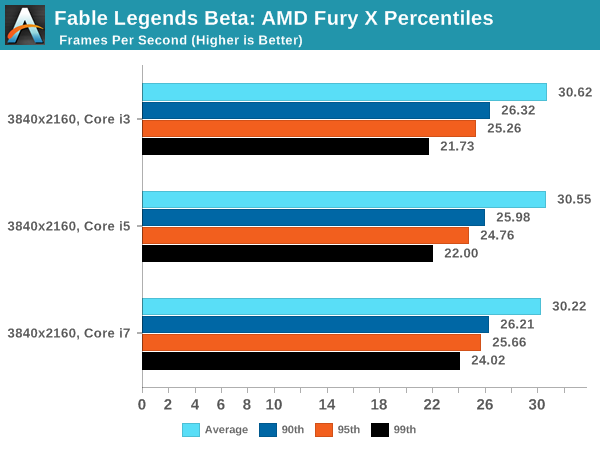
Moving on to the Fury X at 4K and we see all three processor lineups performing similarly, giving us an indication that we are more GPU limited here. There is a slight underline on the Core i7 though, giving slightly lower frame rates in easier scenes but a better frame rate when the going gets tough beyond the 95th percentile.
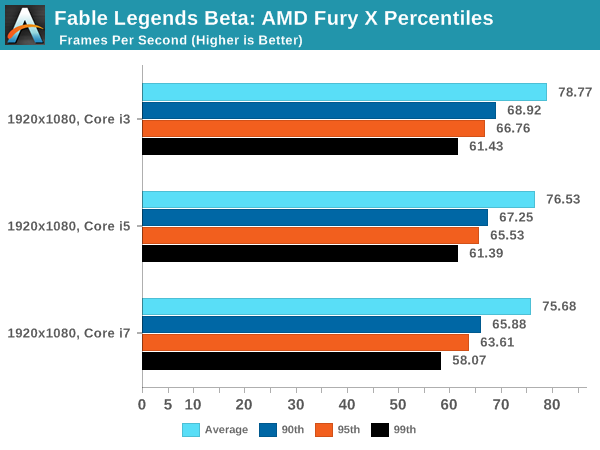
For 1080p, the results take a twist. It almost seems as if we have some form of reverse scaling, whereby more cores is doing more damage to the results. If we have a look at the breakdown provided by the in-game benchmark (given in milliseconds, so lower is better):
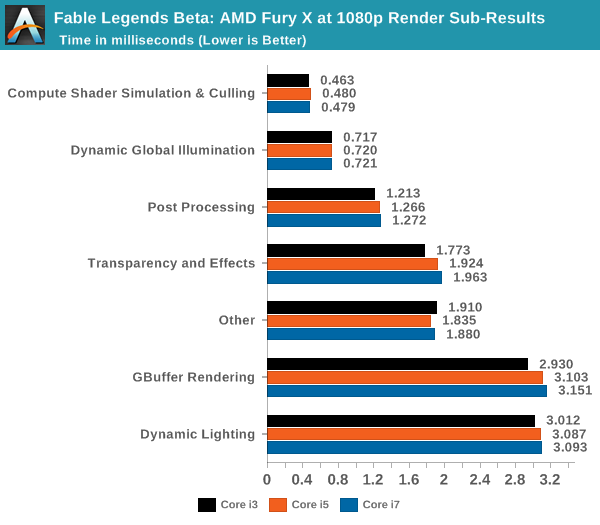
Three areas stand out as benefitting from fewer cores: Transparency and Effects, GBuffer Rendering and Dynamic Lighting. All three are related to illumination and how the illumination interacts with its surroundings. One reason springs to mind on this – with large core counts, too many threads are issuing work to the graphics card causing thread contention in the cache or giving the thread scheduler a hard time depending on what comes in as high priority.
Nevertheless, the situation changes when we move down again to 720p:
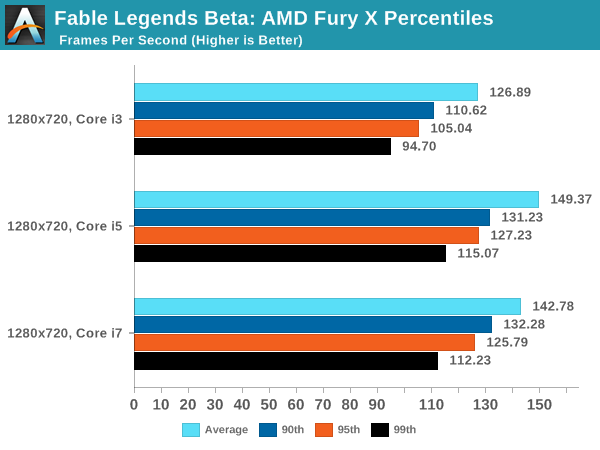
Here the Core i3 takes a nose dive as we become CPU limited to pushing out the frames.


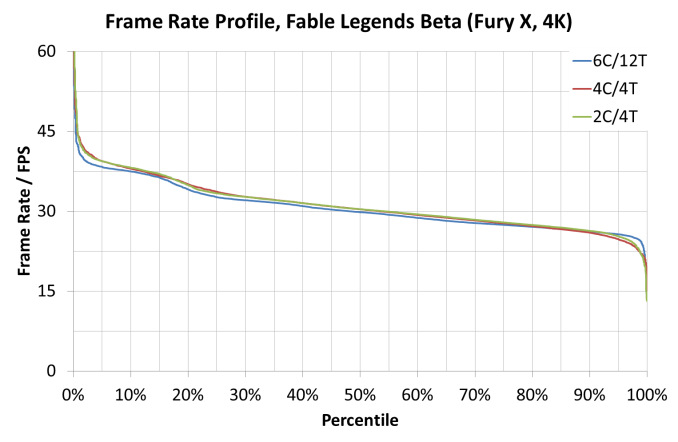
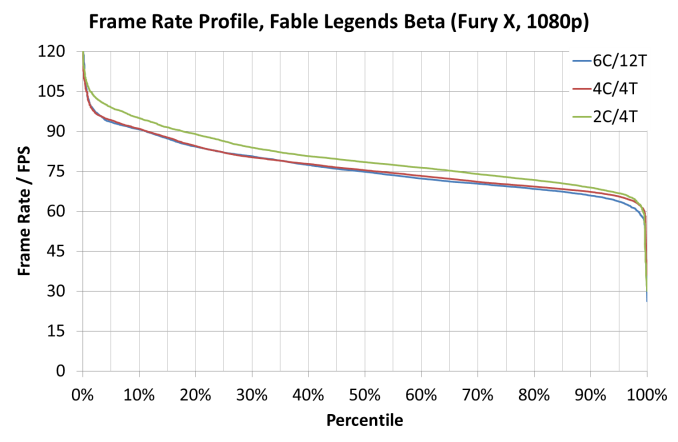
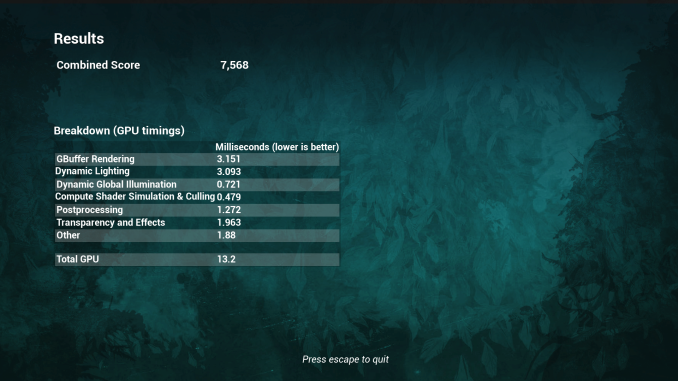
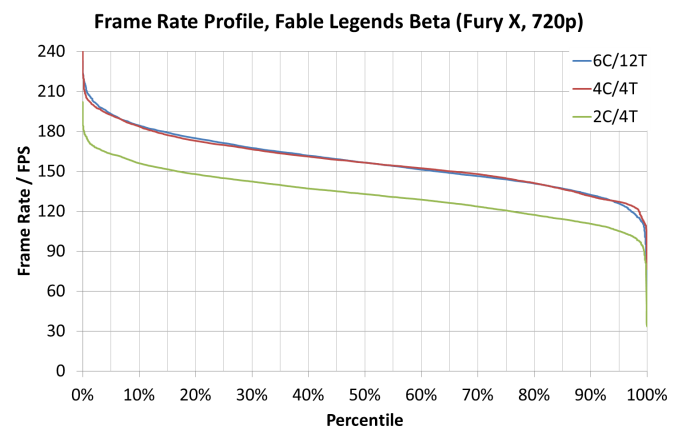








141 Comments
View All Comments
anubis44 - Friday, October 30, 2015 - link
The point is not whether you use DP, the point is that the circuitry is now missing, and that's why Maxwell uses less power. If I leave stuff out of a car, it'll be lighter, too. Hey look! No back seats anymore, and now it's LIGHTER! I'm a genius. It's not because nVidia whipped up a can of whoop-ass, or because they have magic powers, it's because they threw everything out of the airplane to make it lighter.anubis44 - Friday, October 30, 2015 - link
And left out the hardware based scheduler, which will bite them in the ass for a lot of DX12 games that will need this. No WAIT! nVidia isn't screwed! They'll just sell ANOTHER card to the nVidiots who JUST bought one that was obsolete, 'cause nVidia is ALWAYS better!Alexvrb - Thursday, September 24, 2015 - link
Not every game uses every DX12 feature, and knowing that their game is going to run on a lot of Nvidia hardware makes developers conservative in their use of new features that hurt performance on Nvidia cards. For example, as long as developers are careful with async compute and you've got plenty of CPU cycles, I think everything will be fine.Now, look at the 720p results. Why the change in the pecking order? Why do AMD cards increase their lead as CPU power falls? Is it a driver overhead issue - possibly related to async shader concerns? We don't know. Either way it might not matter, an early benchmark isn't even necessarily representative of the final thing, let alone a real-world experience.
In the end it will depend on the individual game. I don't think most developers are going to push features really hard that kill performance on a large portion of cards... well not unless they get free middleware tools and marketing cash or something. ;)
cityuser - Sunday, September 27, 2015 - link
quite sure it's nvidia again do some nasty work with the game company that descale the performance of AMD card !!!Look at where the nvidia cannot corrupt, futuremark's benchmark tells another story!!!
Drumsticks - Thursday, September 24, 2015 - link
As always, it's only one data point. It was too early to declare AMD a winner then, but it's still too early to say they aren't actually going to benefit more from DX12 than Nvidia. We need more data to say for sure either way.geniekid - Thursday, September 24, 2015 - link
That's crazy talk.Beararam - Thursday, September 24, 2015 - link
Maybe not ''vastly superior'', but the gains in the 390x seem to be greater than those realized in the 980. Time will tell.https://youtu.be/_AH6pU36RUg?t=6m29s
justniz - Thursday, September 24, 2015 - link
Such a large gain only on AMD just from DX12 (i.e. accessing the GPU at a lower level and bypassing AMD driver's DX11 implementation) is yet more evidence that AMD's DX11 drivers are much more of a bottleneck than nVidia's.Gigaplex - Thursday, September 24, 2015 - link
That part was pretty obvious. The current question is, how much of a bottleneck. Will DX12 be enough to put AMD in the lead (once final code starts shipping), or just catch up?lefty2 - Thursday, September 24, 2015 - link
I wonder if they were pressurized not to release any benchmark that would make Nvidia look bad, similiar to the way they did in ashes of the singularity